Abstract
Background
Respiratory distress syndrome (RDS) is a significant cause of preterm neonatal morbidity and mortality globally. Measures like the use of antenatal corticosteroids (ACS) and immediate resuscitation of the newborn after birth are taken to abate preterm related complications. Most studies that evidenced the benefit of ACS were done in high resource settings. Therefore, this study was conducted to assess the effectiveness of ACS in reducing RDS and neonatal mortality in preterm neonates in resource-limited settings.
Methods
A three months prospective nested case–control study (1:2 unmatched) was conducted at Muhimbili National Hospital and Amana regional referral hospital in Dar es salaam, Tanzania. Neonates delivered at 28 to 34 gestational weeks were enrolled and followed up until discharge. Data analysis was done using the statistical package of social sciences version 23. Logistic regression analysis was used to determine the effect of ACS on the RDS and mortality in the cohort, controlling for important maternal and neonatal variables. All tests were considered statistically significant at p < 0.05.
Results
Out of 330 preterm neonates enrolled, 110 were cases and 220 were controls. The median gestational age at delivery was 30 weeks and 6 days (IQR 4.68) among cases and 33 weeks (IQR 3) among controls. One-minute APGAR score of < 7 (AOR: 3.11; 95% CI 1.54–6.30), and neonatal birth weight (AOR: 0.998; 95% CI 0.997–0.999) were significantly associated with RDS. No significant association was observed between ACS exposure and RDS occurrence (AOR: 1.65; 95% CI 0.86 – 3.15). The overall mortality rate was 9 per 1000 neonates. Neonatal mortality occurred only among cases whereby, a unit increase in gestational age was associated with a 30% reduction in neonatal mortality (Adjusted hazard ratio, AHR: 0.70, 95% CI: 0.5–0.92, p = 0.011).
Conclusion
Decrease in gestational age, one minute APGAR score of < 7 and decreasing birth weight were associated with RDS among preterm neonates. ACS was not associated with reduced RDS occurrence and neonatal mortality rates. Moreover, increase in gestation age was the only factor found to be protective against preterm neonatal mortality.
Open Access This article is licensed under a Creative Commons Attribution 4.0 International License, which permits use, sharing, adaptation, distribution and reproduction in any medium or format, as long as you give appropriate credit to the original author(s) and the source, provide a link to the Creative Commons licence, and indicate if changes were made. The images or other third party material in this article are included in the article’s Creative Commons licence, unless indicated otherwise in a credit line to the material. If material is not included in the article’s Creative Commons licence and your intended use is not permitted by statutory regulation or exceeds the permitted use, you will need to obtain permission directly from the copyright holder. To view a copy of this licence, visit http://creativecommons.org/licenses/by/4.0/. The Creative Commons Public Domain Dedication waiver (http://creativecommons.org/publicdomain/zero/1.0/) applies to the data made available in this article, unless otherwise stated in a credit line to the data.

